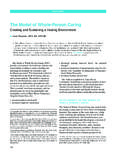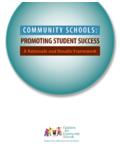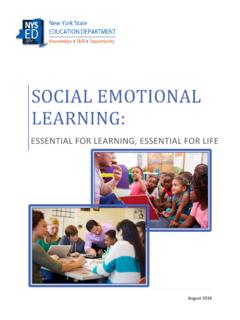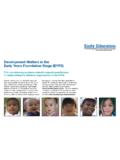Transcription of Junior Cycle Wellbeing Guidelines - NCCA
1 Junior Cycle Wellbeing Guidelines Guidelines for Wellbeing in Junior Cycle 2017. 1. INTRODUCTION 6. Why does Wellbeing matter? 10. The policy context 12. Towards an understanding of student Wellbeing in Junior Cycle 15. 2. Wellbeing AND THE framework FOR Junior Cycle 18. 3. Wellbeing A WHOLE-SCHOOL ENDEAVOUR 24. Four aspects of Wellbeing in schools 26. Teacher Wellbeing 29. The physical environment and Wellbeing 30. Expectations and beliefs and Wellbeing 31. Teaching and learning, and Wellbeing 32. Student voice and Wellbeing 34. Assessment practices and student Wellbeing 35. School policies 36. Student support systems 37. Partnerships with parents and guardians 39. Planning 40. 4. Wellbeing AND THE CURRICULUM 42. Indicators of Wellbeing 44. Wellbeing and the curriculum 46. Guidance 48. Other areas of learning and Wellbeing 50.
2 Planning principles and steps in developing Wellbeing programmes 52. Curriculum for a Wellbeing programme 56. Sample programmes 60. 5. ASSESSMENT AND REPORTING 70. Assessment 72. Reporting on Wellbeing in first and second year 73. 6. Appendices 76. Appendix A: NCCA short courses and Wellbeing programmes at Junior Cycle 78. Appendix B: How the Wellbeing indicators link to the statements of learning and the Staying well key skill 88. Appendix C: Getting started Suggested outline for a staff workshop 89. Appendix D: Using the Wellbeing indicators to review school practice 91. Appendix E: Using Wellbeing indicators to support student self-assessment 92. Appendix F: Student focus group on developing a Wellbeing programme 94. Appendix G: Parent focus group on developing a Wellbeing programme 96. Appendix H: Wellbeing in Junior Cycle : Self-evaluation questionnaire for school management and staff 98.
3 Appendix I: Template to support schools in planning shorter units of learning in Wellbeing 104. 6 Junior Cycle Wellbeing Guidelines 1. Section 1: Introduction 7. INTRODUCTION. 8 Junior Cycle Wellbeing Guidelines The framework for Junior Cycle (2015) provides to build life skills and develop a strong sense for a new area of learning at Junior Cycle called of connectedness to their school and to Wellbeing . Wellbeing will cross the three years their community. The Junior Cycle Wellbeing of Junior Cycle and build on substantial work programme will begin with 300 hours of already taking place in schools in support timetabled engagement in 2017 and build up of students' Wellbeing . This area of learning to 400 hours by 2020 as the new Junior Cycle is will make the school's culture and ethos and implemented fully in schools.
4 Commitment to Wellbeing visible to students. It will include learning opportunities to enhance The aim of these Guidelines is to support schools the physical, mental, emotional and social in planning and developing a coherent Wellbeing Wellbeing of students. It will enable students programme that builds on the understandings, practices and curricula for Wellbeing already existing in schools. There are six sections in the Guidelines . Section 1 sets out why Wellbeing matters as part of Schools Junior Cycle education and the policy context have a central for considering Wellbeing within Junior Cycle education. Section 2 looks at the connections role to play in between Wellbeing and the framework for supporting and Junior Cycle . Section 3 considers the elements promoting students' that contribute to a whole-school approach to learning about Wellbeing , while Section 4 provides an overview Wellbeing and for of planning considerations for and some examples of programmes for Wellbeing .
5 Section Wellbeing . 5 sets out suggestions for how schools can assess and report on student learning in this area of learning. The final section provides tools for planning and evaluating Wellbeing programmes. The development of these Guidelines has been particularly informed by the work of Maeve O'Brien in Wellbeing and Post-Primary Schooling: a Review of the Literature and Research (NCCA, 2008) and the background paper A Human Development framework for Orienting Education and Schools in the Space of Wellbeing (NCCA, 2016) by Maeve O'Brien and Andrew O'Shea. Section 1: Introduction 9. Student Wellbeing is present when students realise their abilities, take care of their physical Wellbeing , can cope with the normal stresses of life, and have a sense of purpose and belonging to a wider community. 10 Junior Cycle Wellbeing Guidelines Why does Wellbeing matter?
6 Wellbeing Wellbeing is gaining increased attention across matters not many education systems. This is influenced by simply because the United Nations Convention on the Rights it leads to better of the Child which emphasises children's right educational outcomes to achieve their full potential and participate or can influence young in decisions that affect them. A rights-based people's outcomes as approach to Wellbeing is useful as it reminds adults. Wellbeing us that Wellbeing matters not simply because matters in the it leads to better educational outcomes or can here and now. influence young people's outcomes as adults. Wellbeing matters in the here and now. It is important in its own right because all students have a right to feel cared for in school. There is also a large body of international That said, we also know that students who research showing an association between have higher levels of Wellbeing tend to have the quality of relationships between teachers better cognitive outcomes in ESRI and students and a number of student research found that children with higher levels outcomes, including socio-emotional Wellbeing , of emotional, behavioural, social and school engagement in schoolwork, feeling a sense Wellbeing had higher levels of academic of belonging in school, levels of disciplinary achievement subsequently (at ages 11, 14, problems, and academic and 16)'.
7 2 Therefore Wellbeing and learning are inextricably connected. Headstrong's My World survey identified key risk and protective factors5 to the mental health It is vital that those who seek to promote high of young people. Among the 12-18-year-olds academic standards and those who seek surveyed (N=7,000) the most powerful predictor to promote mental, emotional and social of good mental health was the presence in their health realise that they are on the same side, lives of at least one good adult' someone who and that social and affective education can knew them personally, believed in them, and support academic learning, not simply take was available to them. Those who could identify time away from it. There is overwhelming such an adult were found to have stronger self- evidence that students learn more effectively, esteem, optimism that they could cope with life's including their academic subjects, if they are challenges, and a sense of Wellbeing .
8 Those happy in their work, believe in themselves, who could not identify any such figure in their and feel school is supporting lives were found to be at high risk for anxiety, depression, acting out and self-harm. For the majority of the adolescents surveyed, their Good Adult' was identified as a parent (most likely their mother), but for many it was a grandparent, older relative or teacher. 1 Student Wellbeing : Literature review. (2015) Centre for Education Statistics and Evaluation. 2 Smyth, E. (2015). Learning in focus: Wellbeing and school experiences among 9-13-year-olds: Insights from the growing up in Ireland study. ESRI/NCCA 3 Weare, K. (2000). Promoting mental, emotional, and social health: A whole-school approach. London: Routledge. 4 Smyth, E. (2015). Learning in focus: Wellbeing and school experiences among 9-13-year-olds: Insights from the growing up in Ireland study.
9 ESRI/NCCA 5 Protective factors are conditions or attributes in individuals, families, schools or the larger society that, when present, increase the health and Wellbeing of children and families. Section 1: Introduction 11. The philosopher, Nel Noddings, suggests that Childhood can be seen as a process of well- care is at the heart of human life and flourishing becoming', where young people are gaining and should be viewed as the ethical ideal of knowledge, skills, values and attitudes that will education. She proposes that sustain them throughout their lives8. This is a lifelong journey, but one where schools play an The primary aim of every educational effort important part. The goal for Wellbeing is human must be the maintenance and enhancement flourishing and flourishing rests on five pillars: of positive emotion, engagement, relationships, Following on from Noddings, other care theorists meaning and accomplishment9.
10 When children have articulated this ethic of care in schools and young people are flourishing', they are not and suggested that the ways in which teachers only curious and eager to learn, they are: model an ethic of care for their students strongly creative and imaginative influences how students develop as learners and connected and empathetic as young people. good team players Having said this, it must also be acknowledged confident about who they are that many of the factors that shape and affect resilient and persistent the Wellbeing of a student lie beyond the reach and influence of schools. Economic, political, positive about themselves and see environmental and social factors all have an themselves growing into better impact on student Wellbeing . The student's Schools have a central role to play in supporting particular family circumstances and context can and promoting students' learning about Wellbeing also have a major influence on their experience and for Wellbeing .










